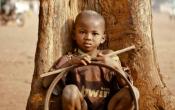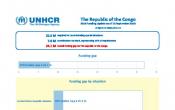Congo
Operation: Congo
Location
{"longitude":16,"latitude":0,"zoom_level":0}
Latest update of camps and office locations 13 Jan 2016. By clicking on the icons on the map, additional information is displayed.
Key Figures
| 2015 end-year results | |
| 6,800 | people were assisted through the issuance of documentation by national institutions |
| 12 | classrooms were constructed to improve educational facilities for CAR refugees in Betou |
| 37% | of older persons of concern received services for their specific needs |
| 19% | of households lived in adequate dwellings |
| 2016 planning figures | |
| 11% | of people of concern (18-59 yrs) with own business/self-employed for more than 12 months (at baseline) |
| 39% | of people of concernwith disabilities receive services for their specific needs (at baseline) |
| 50% | of refugees from the DRC in the primary school-aged children enrolled in primary education (target) |
Latest Updates and Related Links
People of Concern
12%
Decrease in
2015
2015
| 2015 | 52,152 |
| 2014 | 59,105 |
| 2013 | 54,772 |

[["Refugees",44955],["Asylum-seekers",4342],["Returned refugees",1],["Others of concern",2854]]
Loading ...
Budgets and Expenditure for Congo
< Back
2015
{"categories":[2012,2013,2014,2015,2016],"budget":[30.58222392,32.08599964,37.62501547,35.34159306,32.00000031],"expenditure":[13.87705717,14.68758224,13.69277603,10.261615,null]}
{"categories":[2012,2013,2014,2015,2016],"p1":[30.58222392,32.08599964,37.62501547,35.34159306,32.00000031],"p2":[null,null,null,null,null],"p3":[null,null,null,null,null],"p4":[null,null,null,null,null]}
{"categories":[2012,2013,2014,2015,2016],"p1":[13.87705717,14.68758224,13.69277603,10.261615,null],"p2":[null,null,null,null,null],"p3":[null,null,null,null,null],"p4":[null,null,null,null,null]}
Loading ...
CHOOSE A YEAR
- 2014
- 2015
- 2016
Working environment
- Following a biometric registration exercise carried out in 2015, documentation for all refugees over the age of 16 years was issued. This helped mitigate protection risks, which had increased due to police operations against foreigners and arbitrary detention.
- Reluctant to promote local integration for refugees, the authorities implemented measures restricting access to income-generating activities, which increased the need for assistance.
- Few Rwandan refugees expressed a willingness to voluntarily return to their country.
Population trends
- By year end, some 55,000 refugees were recorded, 22,000 of which were from the Central African Republic (CAR), 23,000 from the Democratic Republic of the Congo (DRC), and 9,000 from Rwanda.
Achievements and impact
- All registered persons of concern obtained a valid identity document, and some 650 birth certificates were distributed.
- Food assistance was provided to 17,000 CAR refugees, including 770 infants aged 0 to 59 months and 620 pregnant/breastfeeding women. Acute malnutrition rates fell from 16% to 10%.
- 14 additional blocks of latrines were built in the refugee camps, increasing the number of available toilets to 126. Despite this, the number of people per latrine fell short of the acceptable standard of 20 people per latrine.
Unmet needs
- While 45 per cent of CAR refugees lived in sites with transitory shelters, 55 per cent resided with host families and did not receive sufficient or appropriate shelter support.
- Only 45 per cent of rural refugee children were enrolled in primary education. There were 102 pupils per teacher, which was twice as many as the acceptable standard.
- 140 additional latrines were still needed in refugee camps to reach the standard of 20 persons per latrine.
Working environment
UNHCR’s operations in the Congo focus on protecting and providing life-saving assistance for refugees who fled the ongoing crisis in the Central African Republic (CAR).The Office is committed to finding durable solutions for refugees from the Democratic Republic of the Congo (DRC), who are living in the Likouala region, as well as for Angolan and Rwandan refugees. UNHCR’s efforts to facilitate access to residency cards face serious challenges. The Office will work with the Government of the Congo towards a local integration strategy.
The protection environment has deteriorated with cases of refoulement reported, as well as police operations against foreigners. The implementation of laws forbidding non-nationals from accessing several income generating activities has increased refugees’ dependency on UNHCR.
The local community in the Likouala region has welcomed Central African refugees and the authorities have identified land to develop a new site. The Government has also allowed refugees from all nationalities to attend national schools.
Needs and strategies
The protection strategy in 2015 will continue to focus on the search for durable solutions, particularly in setting out a strategy for the local integration of DRC refugees living in Likouala, and for Rwandan refugees who did not repatriate. Refugees will need assistance to cover the costs of residency cards for their legal integration.The processing of more than 4,000 exemption cases for Rwandan refugees following the June 2013 declaration of the cessation clause will also be a priority. UNHCR’s counterpart, the Comité National d’Assistance aux Réfugiés (CNAR), will need support to build its capacity to do this.
Efforts will focus on ensuring that: CAR refugees are registered; they receive documentation; refugee exposure to sexual and gender-based violence (SGBV) is reduced; refugees can access primary and secondary health care; peaceful cohabitation is promoted; and educational and vocational activities are implemented.
In order to reduce refugees’ dependency on food aid and improve their food security, UNHCR will support livelihood and income-generating activities for them.




